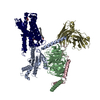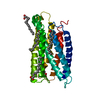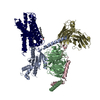+ Open data
Open data
- Basic information
Basic information
| Entry | Database: PDB / ID: 7y13 | |||||||||
|---|---|---|---|---|---|---|---|---|---|---|
| Title | Cryo-EM structure of apo-state MrgD-Gi complex (local) | |||||||||
 Components Components | Soluble cytochrome b562,Mas-related G-protein coupled receptor member D | |||||||||
 Keywords Keywords | SIGNALING PROTEIN / GPCR / Complex | |||||||||
| Function / homology |  Function and homology information Function and homology informationangiotensin-mediated vasodilation involved in regulation of systemic arterial blood pressure / G protein-coupled peptide receptor activity / electron transport chain / G protein-coupled receptor activity / adenylate cyclase-activating G protein-coupled receptor signaling pathway / periplasmic space / electron transfer activity / G protein-coupled receptor signaling pathway / iron ion binding / heme binding ...angiotensin-mediated vasodilation involved in regulation of systemic arterial blood pressure / G protein-coupled peptide receptor activity / electron transport chain / G protein-coupled receptor activity / adenylate cyclase-activating G protein-coupled receptor signaling pathway / periplasmic space / electron transfer activity / G protein-coupled receptor signaling pathway / iron ion binding / heme binding / extracellular space / plasma membrane Similarity search - Function | |||||||||
| Biological species |   Homo sapiens (human) Homo sapiens (human) | |||||||||
| Method | ELECTRON MICROSCOPY / single particle reconstruction / cryo EM / Resolution: 3.1 Å | |||||||||
 Authors Authors | Suzuki, S. / Iida, M. / Kawamoto, A. / Oshima, A. | |||||||||
| Funding support |  Japan, 2items Japan, 2items
| |||||||||
 Citation Citation |  Journal: Commun Biol / Year: 2022 Journal: Commun Biol / Year: 2022Title: Structural insight into the activation mechanism of MrgD with heterotrimeric Gi-protein revealed by cryo-EM. Authors: Shota Suzuki / Momoko Iida / Yoko Hiroaki / Kotaro Tanaka / Akihiro Kawamoto / Takayuki Kato / Atsunori Oshima /  Abstract: MrgD, a member of the Mas-related G protein-coupled receptor (MRGPR) family, has high basal activity for Gi activation. It recognizes endogenous ligands, such as β-alanine, and is involved in pain ...MrgD, a member of the Mas-related G protein-coupled receptor (MRGPR) family, has high basal activity for Gi activation. It recognizes endogenous ligands, such as β-alanine, and is involved in pain and itch signaling. The lack of a high-resolution structure for MrgD hinders our understanding of whether its activation is ligand-dependent or constitutive. Here, we report two cryo-EM structures of the MrgD-Gi complex in the β-alanine-bound and apo states at 3.1 Å and 2.8 Å resolution, respectively. These structures show that β-alanine is bound to a shallow pocket at the extracellular domains. The extracellular half of the sixth transmembrane helix undergoes a significant movement and is tightly packed into the third transmembrane helix through hydrophobic residues, creating the active form. Our structures demonstrate a structural basis for the characteristic ligand recognition of MrgD. These findings provide a framework to guide drug designs targeting the MrgD receptor. | |||||||||
| History |
|
- Structure visualization
Structure visualization
| Structure viewer | Molecule:  Molmil Molmil Jmol/JSmol Jmol/JSmol |
|---|
- Downloads & links
Downloads & links
- Download
Download
| PDBx/mmCIF format |  7y13.cif.gz 7y13.cif.gz | 66.8 KB | Display |  PDBx/mmCIF format PDBx/mmCIF format |
|---|---|---|---|---|
| PDB format |  pdb7y13.ent.gz pdb7y13.ent.gz | 44.8 KB | Display |  PDB format PDB format |
| PDBx/mmJSON format |  7y13.json.gz 7y13.json.gz | Tree view |  PDBx/mmJSON format PDBx/mmJSON format | |
| Others |  Other downloads Other downloads |
-Validation report
| Summary document |  7y13_validation.pdf.gz 7y13_validation.pdf.gz | 1.3 MB | Display |  wwPDB validaton report wwPDB validaton report |
|---|---|---|---|---|
| Full document |  7y13_full_validation.pdf.gz 7y13_full_validation.pdf.gz | 1.3 MB | Display | |
| Data in XML |  7y13_validation.xml.gz 7y13_validation.xml.gz | 25.7 KB | Display | |
| Data in CIF |  7y13_validation.cif.gz 7y13_validation.cif.gz | 35.3 KB | Display | |
| Arichive directory |  https://data.pdbj.org/pub/pdb/validation_reports/y1/7y13 https://data.pdbj.org/pub/pdb/validation_reports/y1/7y13 ftp://data.pdbj.org/pub/pdb/validation_reports/y1/7y13 ftp://data.pdbj.org/pub/pdb/validation_reports/y1/7y13 | HTTPS FTP |
-Related structure data
| Related structure data |  33555MC  7y12C  7y14C  7y15C M: map data used to model this data C: citing same article ( |
|---|---|
| Similar structure data | Similarity search - Function & homology  F&H Search F&H Search |
| EM raw data |  EMPIAR-11074 (Title: Cryo-EM structure of apo-state MrgD-Gi complex / Data size: 3.5 TB EMPIAR-11074 (Title: Cryo-EM structure of apo-state MrgD-Gi complex / Data size: 3.5 TBData #1: K3 movies for apo-state MrgD-Gi complex [micrographs - multiframe]) |
- Links
Links
- Assembly
Assembly
| Deposited unit | 
|
|---|---|
| 1 |
|
- Components
Components
| #1: Protein | Mass: 50141.285 Da / Num. of mol.: 1 Fragment: Chimera protein of Cytochrome b-562 (UNP residues 23-127) and MrgD (UNP residues 5-321) Mutation: M29W, H124I Source method: isolated from a genetically manipulated source Source: (gene. exp.)   Homo sapiens (human) Homo sapiens (human)Gene: cybC, MRGPRD, MRGD / Production host:  | ||||||
|---|---|---|---|---|---|---|---|
| #2: Chemical | ChemComp-PLM / #3: Water | ChemComp-HOH / | Has ligand of interest | N | Has protein modification | Y | |
-Experimental details
-Experiment
| Experiment | Method: ELECTRON MICROSCOPY |
|---|---|
| EM experiment | Aggregation state: PARTICLE / 3D reconstruction method: single particle reconstruction |
- Sample preparation
Sample preparation
| Component | Name: Soluble cytochrome b562,Mas-related G-protein coupled receptor member D Type: COMPLEX / Entity ID: #1 / Source: RECOMBINANT |
|---|---|
| Molecular weight | Experimental value: NO |
| Source (natural) | Organism:  Homo sapiens (human) Homo sapiens (human) |
| Source (recombinant) | Organism:  |
| Buffer solution | pH: 7.4 |
| Specimen | Conc.: 10 mg/ml / Embedding applied: NO / Shadowing applied: NO / Staining applied: NO / Vitrification applied: YES |
| Specimen support | Grid material: GOLD / Grid mesh size: 300 divisions/in. / Grid type: Quantifoil R1.2/1.3 |
| Vitrification | Instrument: FEI VITROBOT MARK IV / Cryogen name: ETHANE / Humidity: 100 % / Chamber temperature: 277 K / Details: blot time 3 seconds blot force 5 |
- Electron microscopy imaging
Electron microscopy imaging
| Experimental equipment |  Model: Titan Krios / Image courtesy: FEI Company |
|---|---|
| Microscopy | Model: FEI TITAN KRIOS |
| Electron gun | Electron source:  FIELD EMISSION GUN / Accelerating voltage: 300 kV / Illumination mode: FLOOD BEAM FIELD EMISSION GUN / Accelerating voltage: 300 kV / Illumination mode: FLOOD BEAM |
| Electron lens | Mode: BRIGHT FIELD / Nominal defocus max: 1900 nm / Nominal defocus min: 700 nm / Cs: 0.01 mm |
| Specimen holder | Cryogen: NITROGEN / Specimen holder model: FEI TITAN KRIOS AUTOGRID HOLDER |
| Image recording | Electron dose: 60 e/Å2 / Film or detector model: GATAN K3 BIOQUANTUM (6k x 4k) |
| EM imaging optics | Spherical aberration corrector: The Microscope implicated Cs corrector. |
- Processing
Processing
| Software | Name: PHENIX / Version: 1.19.2_4158: / Classification: refinement | ||||||||||||||||||||||||
|---|---|---|---|---|---|---|---|---|---|---|---|---|---|---|---|---|---|---|---|---|---|---|---|---|---|
| EM software |
| ||||||||||||||||||||||||
| CTF correction | Type: PHASE FLIPPING AND AMPLITUDE CORRECTION | ||||||||||||||||||||||||
| Symmetry | Point symmetry: C1 (asymmetric) | ||||||||||||||||||||||||
| 3D reconstruction | Resolution: 3.1 Å / Resolution method: FSC 0.143 CUT-OFF / Num. of particles: 349331 / Symmetry type: POINT | ||||||||||||||||||||||||
| Refine LS restraints |
|
 Movie
Movie Controller
Controller






 PDBj
PDBj















